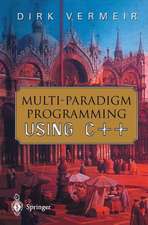Java Generics and Collections: Java Ser.
Autor Maurice Naftalin, Philip Wadleren Limba Engleză Paperback – 2 noi 2006
Preț: 205.60 lei
Preț vechi: 257.00 lei
-20% Nou
Puncte Express: 308
Preț estimativ în valută:
39.35€ • 40.93$ • 32.48£
39.35€ • 40.93$ • 32.48£
Carte tipărită la comandă
Livrare economică 15-29 aprilie
Preluare comenzi: 021 569.72.76
Specificații
Public țintă
Academic/professional/technical: Undergraduate. Academic/professional/technical: Postgraduate. Academic/professional/technical: Research and professionalCuprins
Preface;
Obtaining the Example Programs;
How to Contact Us;
Conventions Used in This Book;
Using Code Examples;
Safari® Books Online;
Acknowledgments;
Part I: Generics;
Chapter 1: Introduction;
1.1 Generics;
1.2 Boxing and Unboxing;
1.3 Foreach;
1.4 Generic Methods and Varargs;
1.5 Assertions;
Chapter 2: Subtyping and Wildcards;
2.1 Subtyping and the Substitution Principle;
2.2 Wildcards with extends;
2.3 Wildcards with super;
2.4 The Get and Put Principle;
2.5 Arrays;
2.6 Wildcards Versus Type Parameters;
2.7 Wildcard Capture;
2.8 Restrictions on Wildcards;
Chapter 3: Comparison and Bounds;
3.1 Comparable;
3.2 Maximum of a Collection;
3.3 A Fruity Example;
3.4 Comparator;
3.5 Enumerated Types;
3.6 Multiple Bounds;
3.7 Bridges;
3.8 Covariant Overriding;
Chapter 4: Declarations;
4.1 Constructors;
4.2 Static Members;
4.3 Nested Classes;
4.4 How Erasure Works;
Chapter 5: Evolution, Not Revolution;
5.1 Legacy Library with Legacy Client;
5.2 Generic Library with Generic Client;
5.3 Generic Library with Legacy Client;
5.4 Legacy Library with Generic Client;
5.5 Conclusions;
Chapter 6: Reification;
6.1 Reifiable Types;
6.2 Instance Tests and Casts;
6.3 Exception Handling;
6.4 Array Creation;
6.5 The Principle of Truth in Advertising;
6.6 The Principle of Indecent Exposure;
6.7 How to Define ArrayList;
6.8 Array Creation and Varargs;
6.9 Arrays as a Deprecated Type?;
6.10 Summing Up;
Chapter 7: Reflection;
7.1 Generics for Reflection;
7.2 Reflected Types are Reifiable Types;
7.3 Reflection for Primitive Types;
7.4 A Generic Reflection Library;
7.5 Reflection for Generics;
7.6 Reflecting Generic Types;
Chapter 8: Effective Generics;
8.1 Take Care when Calling Legacy Code;
8.2 Use Checked Collections to Enforce Security;
8.3 Specialize to Create Reifiable Types;
8.4 Maintain Binary Compatibility;
Chapter 9: Design Patterns;
9.1 Visitor;
9.2 Interpreter;
9.3 Function;
9.4 Strategy;
9.5 Subject-Observer;
Part II: Collections;
Chapter 10: The Main Interfaces of the Java Collections Framework;
Chapter 11: Preliminaries;
11.1 Iterable and Iterators;
11.2 Implementations;
11.3 Efficiency and the O-Notation;
11.4 Contracts;
11.5 Collections and Thread Safety;
Chapter 12: The Collection Interface;
12.1 Using the Methods of Collection;
12.2 Implementing Collection;
12.3 Collection Constructors;
Chapter 13: Sets;
13.1 Implementing Set;
13.2 SortedSet and NavigableSet;
13.3 Comparing Set Implementations;
Chapter 14: Queues;
14.1 Using the Methods of Queue;
14.2 Implementing Queue;
14.3 BlockingQueue;
14.4 Deque;
14.5 Comparing Queue Implementations;
Chapter 15: Lists;
15.1 Using the Methods of List;
15.2 Implementing List;
15.3 Comparing List Implementations;
Chapter 16: Maps;
16.1 Using the Methods of Map;
16.2 Implementing Map;
16.3 SortedMap and NavigableMap;
16.4 ConcurrentMap;
16.5 ConcurrentNavigableMap;
16.6 Comparing Map Implementations;
Chapter 17: The Collections Class;
17.1 Generic Algorithms;
17.2 Collection Factories;
17.3 Wrappers;
17.4 Other Methods;
Colophon;
Obtaining the Example Programs;
How to Contact Us;
Conventions Used in This Book;
Using Code Examples;
Safari® Books Online;
Acknowledgments;
Part I: Generics;
Chapter 1: Introduction;
1.1 Generics;
1.2 Boxing and Unboxing;
1.3 Foreach;
1.4 Generic Methods and Varargs;
1.5 Assertions;
Chapter 2: Subtyping and Wildcards;
2.1 Subtyping and the Substitution Principle;
2.2 Wildcards with extends;
2.3 Wildcards with super;
2.4 The Get and Put Principle;
2.5 Arrays;
2.6 Wildcards Versus Type Parameters;
2.7 Wildcard Capture;
2.8 Restrictions on Wildcards;
Chapter 3: Comparison and Bounds;
3.1 Comparable;
3.2 Maximum of a Collection;
3.3 A Fruity Example;
3.4 Comparator;
3.5 Enumerated Types;
3.6 Multiple Bounds;
3.7 Bridges;
3.8 Covariant Overriding;
Chapter 4: Declarations;
4.1 Constructors;
4.2 Static Members;
4.3 Nested Classes;
4.4 How Erasure Works;
Chapter 5: Evolution, Not Revolution;
5.1 Legacy Library with Legacy Client;
5.2 Generic Library with Generic Client;
5.3 Generic Library with Legacy Client;
5.4 Legacy Library with Generic Client;
5.5 Conclusions;
Chapter 6: Reification;
6.1 Reifiable Types;
6.2 Instance Tests and Casts;
6.3 Exception Handling;
6.4 Array Creation;
6.5 The Principle of Truth in Advertising;
6.6 The Principle of Indecent Exposure;
6.7 How to Define ArrayList;
6.8 Array Creation and Varargs;
6.9 Arrays as a Deprecated Type?;
6.10 Summing Up;
Chapter 7: Reflection;
7.1 Generics for Reflection;
7.2 Reflected Types are Reifiable Types;
7.3 Reflection for Primitive Types;
7.4 A Generic Reflection Library;
7.5 Reflection for Generics;
7.6 Reflecting Generic Types;
Chapter 8: Effective Generics;
8.1 Take Care when Calling Legacy Code;
8.2 Use Checked Collections to Enforce Security;
8.3 Specialize to Create Reifiable Types;
8.4 Maintain Binary Compatibility;
Chapter 9: Design Patterns;
9.1 Visitor;
9.2 Interpreter;
9.3 Function;
9.4 Strategy;
9.5 Subject-Observer;
Part II: Collections;
Chapter 10: The Main Interfaces of the Java Collections Framework;
Chapter 11: Preliminaries;
11.1 Iterable and Iterators;
11.2 Implementations;
11.3 Efficiency and the O-Notation;
11.4 Contracts;
11.5 Collections and Thread Safety;
Chapter 12: The Collection Interface;
12.1 Using the Methods of Collection;
12.2 Implementing Collection;
12.3 Collection Constructors;
Chapter 13: Sets;
13.1 Implementing Set;
13.2 SortedSet and NavigableSet;
13.3 Comparing Set Implementations;
Chapter 14: Queues;
14.1 Using the Methods of Queue;
14.2 Implementing Queue;
14.3 BlockingQueue;
14.4 Deque;
14.5 Comparing Queue Implementations;
Chapter 15: Lists;
15.1 Using the Methods of List;
15.2 Implementing List;
15.3 Comparing List Implementations;
Chapter 16: Maps;
16.1 Using the Methods of Map;
16.2 Implementing Map;
16.3 SortedMap and NavigableMap;
16.4 ConcurrentMap;
16.5 ConcurrentNavigableMap;
16.6 Comparing Map Implementations;
Chapter 17: The Collections Class;
17.1 Generic Algorithms;
17.2 Collection Factories;
17.3 Wrappers;
17.4 Other Methods;
Colophon;



























